Winthrop Hall
University of Western Australia, Stirling Highway, Crawley
B. 1965 J.W. Walker & Sons., Ruislip, Middlesex.
Tonal altns 1978 & c1990 F.J.Larner and Co.
3 manuals, 49 speaking stops, 13 couplers, electro-pneumatic action
Rebuilt by South Island Organ Company Ltd, Timaru, New Zealand 2008
3 manuals, 55 speaking stops, 12 couplers, electro-pneumatic action
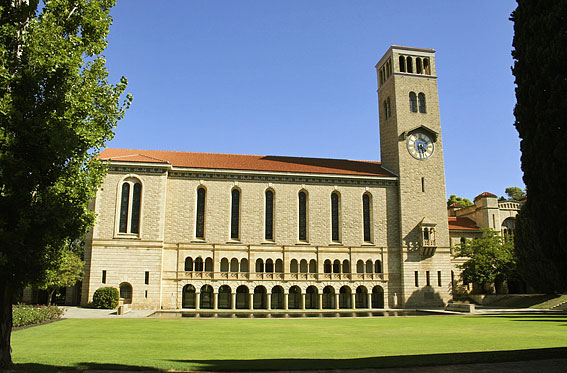

Information and specification taken from the 1993 OHTA Conference handbook and the University website:
The organ prior to 2008
|
The organ is a quality 3 manual and pedal instrument designed and built for Winthrop Hall in 1965 by the prestigious English firm of J W Walker Ltd. The specification is economically resourceful and the tonal style is a typical English interpretation of the "neo-baroque" style in vogue at the time. It is still musically and aesthetically effective in the hall. The action is a combination of traditional English electropneumatic slider chests with slider seals, and unit chests with electromechanical switching. The winding features schwimmer regulators and small single-rise ribbed reservoirs. The voicing is all on low wind-pressure, open-toe fluework and French style reeds.
Compass of manuals CC to C, 61 notes |
| Great Organ | Swell Organ | |||
| 1 Quintaton |
16ft |
12 Open diapason |
8 ft |
|
| 2 Open diapason |
8 |
13 Gedeckt |
8 |
|
| 3 Principal |
8 |
14 Viola da gamba |
8 |
|
| 4 Spitzflute |
8 |
15 Celeste TC |
8 |
|
| 5 Octave |
4 |
16 Gemshorn |
4 |
|
| 6 Rohrflute |
4 |
17 Koppelflute |
4 |
|
| 7 Twelfth |
2 2/3 |
18 Fifteenth |
2 |
|
| 8 Fifteenth |
2 |
19 Mixture 22.26.29.33 |
IV |
|
| 9 Sesquiattera 12.17 |
II |
20 Contra bassoon |
16 |
|
| 10 Mixture 19.22.26.29 |
IV |
21 Cornopean |
8 |
|
| 11 Trompette |
8 |
22 Bassoon (from 20) |
8 |
|
| 23 Clarion |
4 |
|||
| Tremulant | ||||
| Positive Organ | Pedal Organ | |||
| 24 Stopped Diapason |
8 ) as |
36 Dble open diapason |
32 |
|
| 25 Salicional |
8 ) choir |
37 Principal (from 36) |
16 |
|
| 26 Vienna flute |
4 ) organ |
38 Bourdon |
16 |
|
| 27 Nazard |
2 2/3 |
39 Quintaton (from 1) |
16 |
|
| 28 Principal |
2 |
40 Octave |
8 |
|
| 29 Blockflute |
2 |
41 Bass flute (from 38) |
8 |
|
| 30 Tierce |
1 3/5 |
42 Fifteenth (from 40) |
4 |
|
| 31 Larigot |
1 1/3 |
43 Octave flute (from 38) |
4 |
|
| 32 Cymbal 33.36 |
II |
44 Mixture 22.26.29 |
III |
|
| 33 Krumhorn |
8 |
45 Trombone |
16 |
|
| 34 Trompette (from 11) |
8 |
46 Bassoon (from 20) |
16 |
|
| 35 Trumpet real + C (horizontal ) |
8 |
47 Trumpet (from 45) |
8 |
|
| tremulant | ||||
| Couplers | Accessories | |||
| Positive to pedal | 6 thumb pistons to positive | |||
| Great to pedal | 6 thumb pistons to great | |||
| Swell to pedal | 6 thumb pistons to swell | |||
| Swell to great | 6 toe pistons to pedal | |||
| Positive to great | 6 toe pistons to swell | |||
| Swell to positive | 4 general thumb pistons | |||
| Swell octave | 4 general toe pistons | |||
| Swell sub octave | 1 reversible thumb & toe piston for great to pedal | |||
| Swell octave | ||||
| Choir sub octave | 1 reversible thumb piston swell to great | |||
| Choir unison off | 1 reversible thumb piston positive to great | |||
| Swell unison off | Balanced swell pedal | |||
| Great & pedal combination coupler | Balanced crescendo pedal | |||
From OHTA News April 2007 and Organ Australia March 2007, South Island Organ Company Ltd reports:
Immediately after Easter 2007, SIOC will commence restoration of the 1965 JW Walker organ in Winthrop Hall, University of Western Australia. The project will involve dismantling the whole organ so that the platform can be deepened to facilitate reorganisation of the layout for improved maintenance access. The original enclosed Choir division will be recreated with the reinstatement of the original Orchestral Flute 8 and addition of Vox Humana 8 and Vox Angelica 8 stops. The Positive division will be made independent with the reinstatement of its own Chimney Flute 8 and Nason Flute 4. The Great will receive a Clarion 4 and the Swell a Bourdon 16. The Pedal division will receive a full length Pedal Contra Trombone 32 and Echo Bourdon 16, to complete the organ in the original neo-classical style. Completion is due for March 2008.
From OHTA News April 2008:
WINTHROP HALL ORGAN INSTALLATION REVIEW
by Patrick Elms & John Hargraves
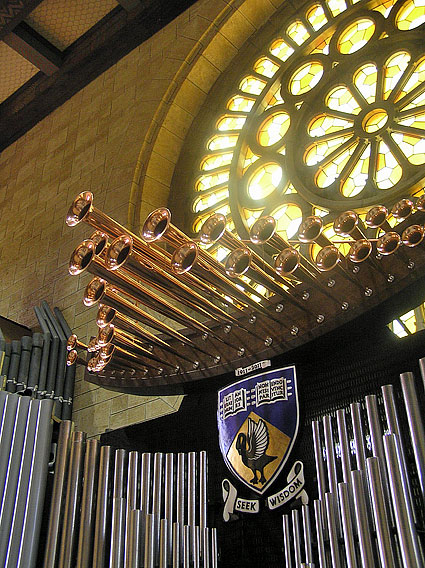
The reinstallation of the 1965 J.W. Walker & Sons Ltd McGillivray memorial organ at Winthrop Hall, University of WA was completed in nine weeks, exactly on schedule, on Saturday 8 March, some 11 months after it was removed from the hall in April 2007.
Since that time it has received comprehensive restoration and rebuilding at the South Island Organ Co. factory in Timaru, NZ – the six slider windchests and numerous off note chests being completely restored according to their 1964 manufacture, as were the 13 schwimmer wind regulators and five traditional single-rise reservoirs (including reinstatement of their unique internal springing system with new constant force springs obtained from the original suppliers – thanks to the wonders of Google!). Complete cleaning and attention to the approximately 3000 pipes, reinstatement of the independence of the Choir and Positive divisions and reinstatement of the Choir expression shutters, completion of the tonal scheme with carefully scaled and voiced stop additions and replacement of the obsolete electrical transmission, coupling and combination systems with a modern fully featured computerised system by Peterson USA. The organ platform has been deepened by 600mm and some of the electro-pneumatic actions have been replaced with electric ones to allow for improved internal access. Entry is still pretty tight, but walking instead of crawling through the organ is now mostly possible and a huge improvement for future tuning and maintenance with no loss of performance potential.
The result: the organ has far more presence in the hall – the necessary voicing adjustments and regulating to the Pedal 32’ and 16’ Principals, addition of a Swell Bourdon 16’ and Pedal Contra Trombone 32’ have all given the organ far more ‘gravitas’, as has the general slowing of speech of all the Principal choruses throughout the organ which has further emphasised the fundamental tone of the organ. The bottom notes of the 32’ are haskelled and the tremulants are of fan construction, rather like those in American reed organs, but on a larger scale: these are characteristic features of Walker instruments of the period.
The reeds are far brighter and prompt in speech – especially the swell reeds. The Swell windchests have four wind regulators, each of which was found during the factory work to have had a different wind pressure due to breakage or misalignment of the internal pressure springs – none of the wind pressures being anywhere close to that recorded as being set in 1964. The background air noise formerly prevalent from inaccessible leakage is now silent.
The reinstatement of the independent expressive Choir division playable from either Choir or Swell should be especially useful in the realisation of Romantic repertoire (yes, organists do want to play Romantic literature on a neo classical instrument!) – the new Vox Angelica is a lovely contrast to the keener swell strings and the new Orchestral Flute (the original pipes, removed in 1978 to Christ Church, Ormond, Victoria, were unable to be recovered) a fine contrast to the other flutes of the organ, all of which have responded beautifully at the hands of SIOC voicer John Gray: all the flutes throughout the organ have a distinctly different character which was not so evident previously. The new Vox Humana is also a fine contrast to its larger brother in the Positive, the Crumhorn.
The Positive organ is far more cohesive from again having its own 8’ and 4’ foundations, rather than borrowing them from the Choir as was the case since alteration in the 1980s. This is also the case with the Great and Swell Principal choruses which, rather than being spread out over two different windchests in each division (Swell double-decked and Great each side of the rose window), have now been planted together on their respective windchests, thus speaking together from the same pallets. They are much more solid and cohesive in their speech and tuning.
Of course the crowning glory of the instrument is the new Trumpet Real. It is voiced on 130mm of wind and has a very forthright, round and bright tone. It is full length to bottom C – previously it only went to tenor C and the lowest six notes had half length resonators which somewhat spoilt the effect. The organ formerly depended on it for chorus impact but this is no longer the case – the organ now has plenty of impact in its own right and the new Trumpet Real fulfils its ceremonial and repertoire roles with appropriate éclat!
Visually the facade of the Positive division has been subtly altered to accommodate a new UWA shield in cast aluminium and the new display chest for the spun copper Trumpet Real pipes. This additional work was the happy outcome of a design idea and bequest by Dr Jim Rowlands who felt strongly that the original design was weak at this point.
The team working on the organ has included in New Zealand - John Hargraves, John Gray, Neil Stocker, Gerald Green, Christopher Templeton, Willie Walford, Martin Gottlieb, John Cookson and Jim Parnell, and in Australia - Patrick Elms, Colin van der Lecq and Jim Rowlands with assistance from UWA Theatres staff.
The organ will be used publicly for the first time on 31 March 2008 when UWA titular organist Annette Goerke presides over the University graduation ceremonies for three weeks. An opening concert by Annette Goerke is planned for 4 May.
Built by J.W. Walker & Sons Ltd, Ruislip, Middlesex, United Kingdom 1965
Tonal alterations by F.J. Larner & Co., Perth, WA, 1978 and c.1990
Rebuilt by South Island Organ Company Ltd, Timaru, New Zealand 2008
| GREAT Quintaton Open Diapason Principal Spitz Flute Octave Rohr Flute Twelfth Fifteenth Larigot Mixture 19.22.26.29 Trompette Clarion SWELL Bourdon Open Diapason Gedackt Viola da Gamba Voix Celeste Gemshorn Koppel Flute Fifteenth Mixture 22.26.29.33 Contra Bassoon Cornopean Bassoon Clarion |
16 8 8 8 4 4 2-2/3 2 1-1/3 IV 8 4 16 8 8 8 8 4 4 2 IV 16 8 8 4 |
A B * C* TC D D |
| POSITIVE Stopped Diapason Nason Flute Nazard Principal Block Flute Tierce Cymbal 33.36 Sesquialtera 12.17 Crumhorn Trompette Trumpet Real CHOIR (enclosed) Orchestral Flute Salicional Vox Angelica Vienna Flute Vox Humana PEDAL Double Open Diapason Principal Bourdon Quintaton Echo Bourdon Octave Bass Flute Fifteenth Flute Mixture 22.26.29 Contra Trombone Trombone Bassoon Trumpet |
8 4 2-2/3 2 1-3/5 II II 8 8 8 8 8 8 4 8 32 16 16 16 16 8 8 4 4 III 32 16 16 8 |
* B * * * TC * F F G A C* H G H G I* I D I |
| COUPLERS Swell Octave Octave Swell Sub Octave Swell Unison Off Choir Octave Choir Sub Octave Choir Unison Off Swell to Great Swell to Positive Positive to Great Swell to Pedal Great to Pedal Positive to Pedal ACCESSORIES Swell Tremulant Choir Tremulant Positive Tremulant |
Swell expression motor (16 stage)
Choir expression motor (16 stage)
Taxi console with ethernet transmission
Capture System – Peterson ICS-4000
· 256 level piston capture system with green fluorescent control panel.
· 2 open (guest) & up to 10 organist folders (password lockout).
· COPY facility copies contents of a selected level from any organist folder to the current level of the open user area or to external memory thru the USB port.
· American stop sequencer with insert facility and song lists.
· Built in performance recording/playback system.
· 6 divisional pistons to Great, Choir & Positive combined (thumb), Pedal (toe).
· 6 divisional pistons to Swell (thumb and toe).
· 10 general pistons (thumb and toe).
· Swell to Great, Positive to Great, Swell to Positive reversible thumb pistons, Great to Pedal (thumb & toe piston).
· General Cancel thumb piston.
· Drawstop to Great & Pedal Piston Coupler (2 way).
· Duplicate thumb pistons for SET and Sequencer NEXT, RESTORE, LAST, functions.
· Reversible toe piston for NEXT function.
· Programmable crescendo pedal with 4 settable programmes of up to 60 general combinations each.
· Transposer – 6 semitones up or down.
· Illuminated reversible thumb piston for - Register Crescendo ON (and Choir Expression to Swell Pedal).
· Illuminated reversible thumb piston for - Invert Manuals II & I (together with manual pistons).
· Illuminated reversible thumb pistons for Choir On Swell and Choir Off Positive.
· MIDI IN, MIDI OUT, INSTRUMENT OUT ports.
· MIDI control of sound modules by illuminated reversible thumb pistons – MIDI to Great, MIDI to Swell, MIDI to Choir/Positive, MIDI to Pedal.
· Digital Clock.
· Piston compassing
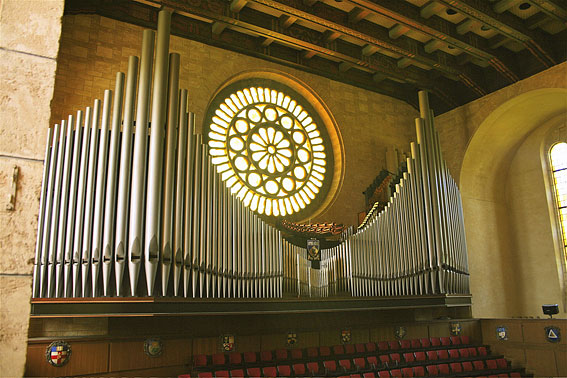

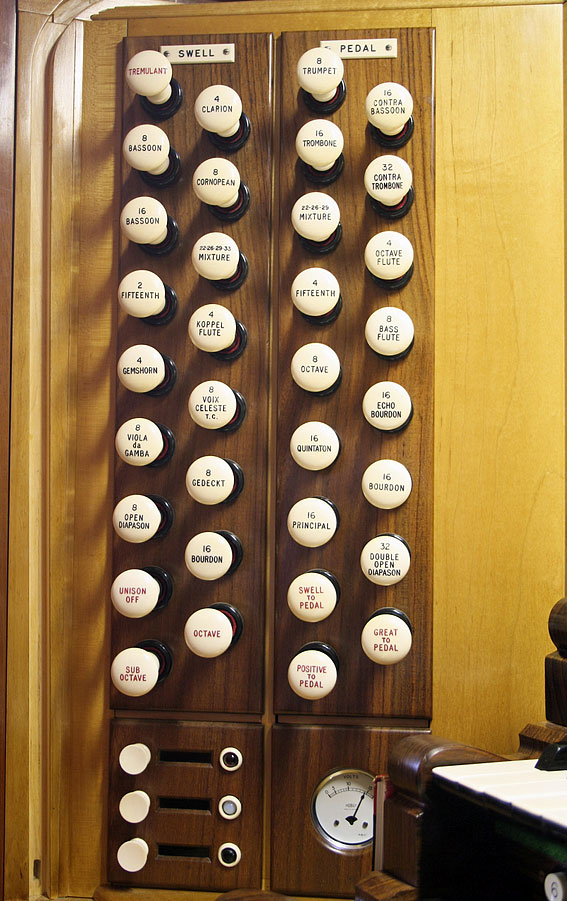
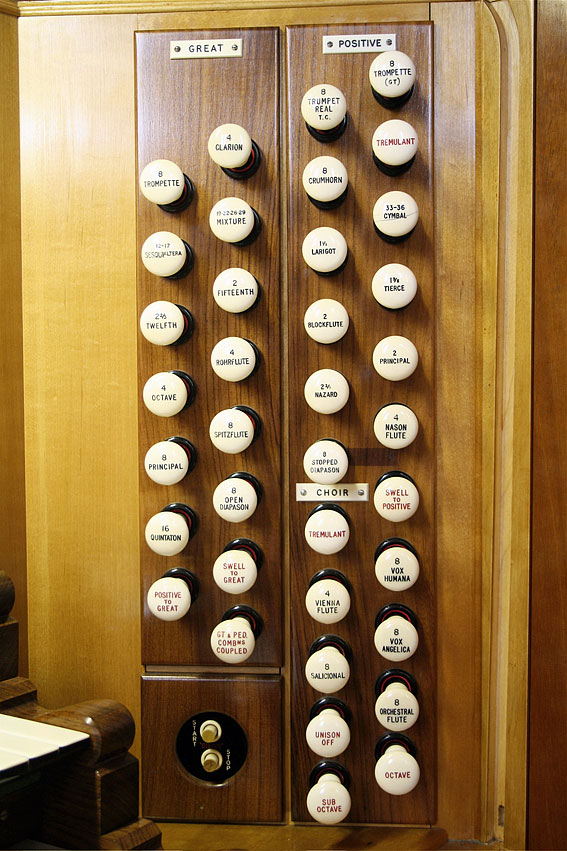

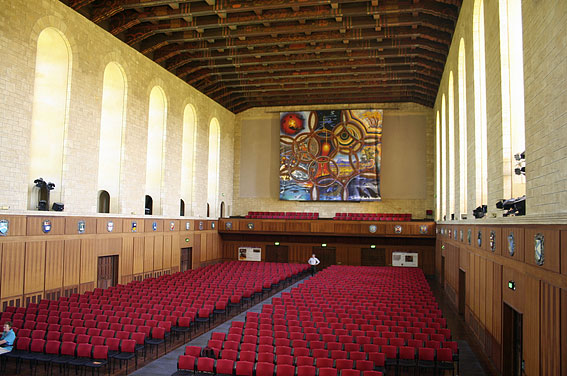
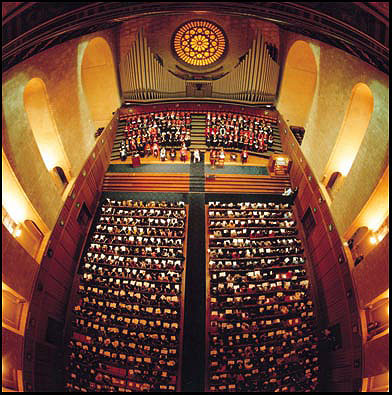
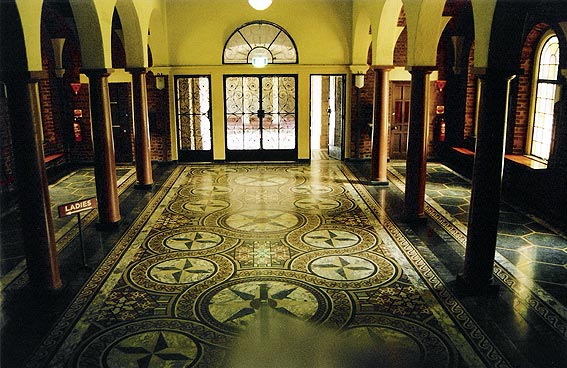
Photo: Trevor Bunning (2000)
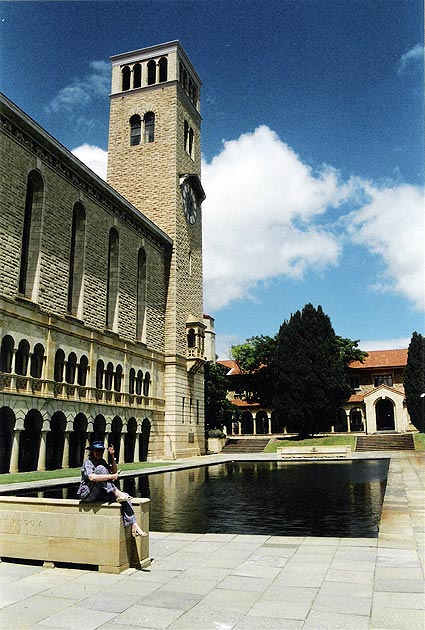
Photo: Trevor Bunning (2000)
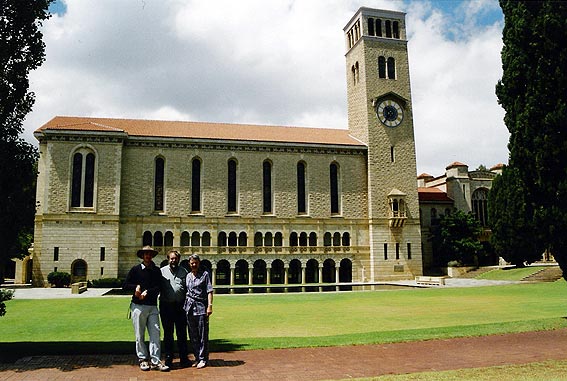
Photos: Trevor Bunning (Dec. 2000)

Photo: Trevor Bunning (2000)

Photo: Trevor Bunning (2000)
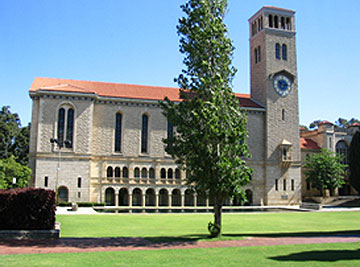
Photos: Trevor Bunning (March 2009) unless stated otherwise